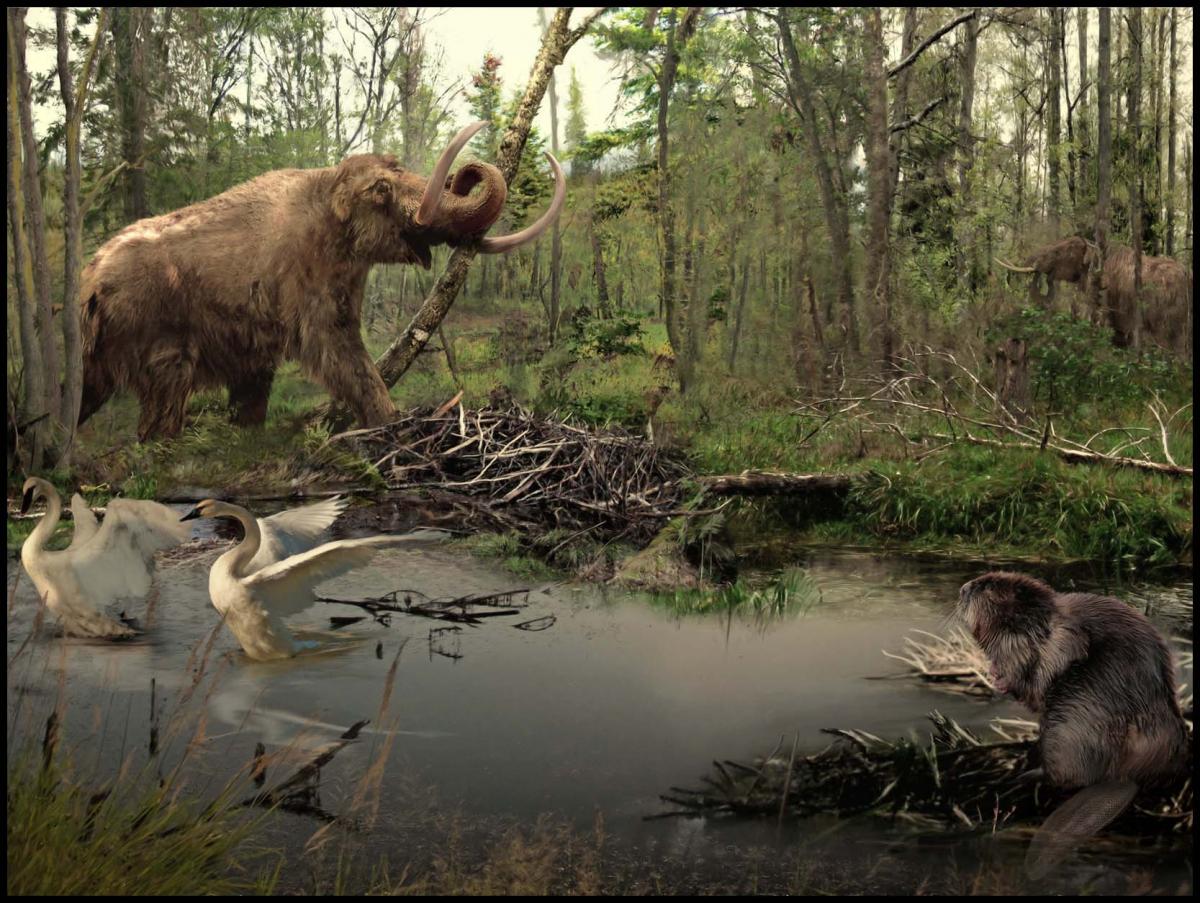 The landscape of the Midwest was very different during the terminal Pleistocene. Although glaciers were retreating, much of the Midwest was still under ice. Some areas had been only recently deglaciated. These areas may have been covered with bare sheets of till that were slowly being revegetated. Large, proglacial lakes formed where morraines dammed the water coming off the melting glaciers. Dust storms were depositing thick layers of loess (windblown dust) over many areas. Lakes, marshes, and mires were common.
The landscape of the Midwest was very different during the terminal Pleistocene. Although glaciers were retreating, much of the Midwest was still under ice. Some areas had been only recently deglaciated. These areas may have been covered with bare sheets of till that were slowly being revegetated. Large, proglacial lakes formed where morraines dammed the water coming off the melting glaciers. Dust storms were depositing thick layers of loess (windblown dust) over many areas. Lakes, marshes, and mires were common.Late Pleistocene Biomes
 The landscape of the Midwest was very different during the terminal Pleistocene. Although glaciers were retreating, much of the Midwest was still under ice. Some areas had been only recently deglaciated. These areas may have been covered with bare sheets of till that were slowly being revegetated. Large, proglacial lakes formed where morraines dammed the water coming off the melting glaciers. Dust storms were depositing thick layers of loess (windblown dust) over many areas. Lakes, marshes, and mires were common.
The landscape of the Midwest was very different during the terminal Pleistocene. Although glaciers were retreating, much of the Midwest was still under ice. Some areas had been only recently deglaciated. These areas may have been covered with bare sheets of till that were slowly being revegetated. Large, proglacial lakes formed where morraines dammed the water coming off the melting glaciers. Dust storms were depositing thick layers of loess (windblown dust) over many areas. Lakes, marshes, and mires were common.
 |
Forest Tundra Steppe and forest tundra characterize the landscape at glacial margins, at the height of late Wisconsinan glaciation in the Great Lakes region. This environment has no modern analogue. In more mesic eastern parts of the Midwest, trees were more common landscape elements in tundra-like environments, thus the name Forest Tundra. Uplands would been predominantly grasslands, with occasional trees (Spruce and Larch). Lowland areas were moderately wet, with willow, sedges, and herbs dominant. |
 |
Spruce Ash Forest This biome is characterized by a cold and wet climate promoting a woodland dominated by spruce and black ash with no modern analogue. A variety of coniferous and deciduous trees such as larch, fir, oak, elm, and hop hornbean are also present in lower percentages on the landscape. Deciduous elements spread into the Midwest for the first time since the last glacial maximum. The landscape itself is very wet. Lowlands and riparian areas are saturated, promoting the widespread development of wetlands and semi-aquatic plant communities dominated by sedges and bulrushes.
|
 |
Spruce Forests and Parklands As the glaciers receded, pioneering tundra vegetation was replaced with spruce forests and sedge-dominated wetlands. There is no modern analogue for this biome. Grasses and scattered trees were present in the uplands. These trees would have been largely white and black spruce. Lowlands along rivers and streams were dominated by black spruce, a species that is adapted to cold, saturated environments. Sedges were also common in lowland habitats (Yansa and Adams 2012; Gonzalez and Grimm 2009).
|
 |
Spruce Pine Forests and Parklands Away from the glacial front in the southern Midwest and Southeastern US, forests and parklands were less cold-adapted. Although spruce was still a component of the regional vegetation, it is often sub-dominant to pines, which are less cold-tolerant. These major components change throughout the last 20,000 years. As climate cools, spruce increases, as it warms, pine becomes more prominent. Deciduous trees are also present. Oak begins increasing ~16,000 years ago and becomes dominant in the early Holocene, ~12,000 years ago.
|
 |
Steppe Tundra Steppic and forest tundra characterize the landscape at glacial margins, at the height of late Wisconsin glaciation in the Great Lakes region. This late Ice Age "Tundra-like" biome was a relatively open landscape, with fewer trees and more grasses, sedges, and herbaceous vegetation. At a regional scale, there was likley a mosaic of vegetation patches, including tundra, open boreal woodlands, mixed coniferous-deciduous forest, and pine woodlands (Yansa and Adams 2012). |

